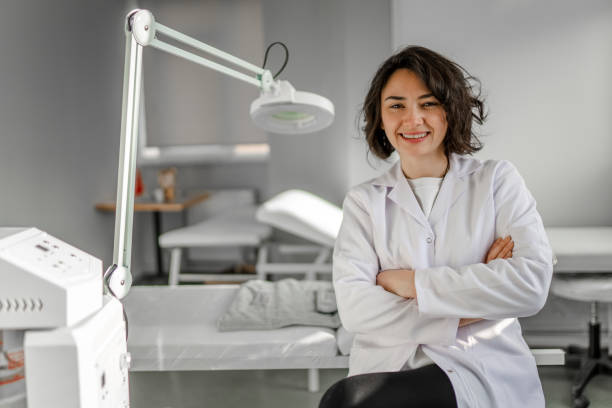Cyst Removal Recovery: What to Expect After the Procedure

Understanding the Healing Journey After Cyst Removal
The cyst removal recovery process is very important for getting good results. Having an idea of recovery after minor or complex surgery not only helps healing but also cuts down on scarring and may reduce the chance of problems.
When the cyst is removed, your skin goes through a sensitive healing process. This process includes inflammation, tissue regeneration, and skin remodelling. Each step after surgery needs special care, such as cleaning up the area and knowing when to return to your routine.
Patients often ask questions like:
- For how long do the wounds take to heal after cyst removal?
- Will there be a scar?
- Can I shower, work out, or return to work
- What are the signs of infection?
The article discusses the important points of cyst removal recovery. We will talk you through each step, starting from the first day until the weeks ahead, so you know what to expect during cyst removal recovery.
You will also get useful advice on how to recover more quickly, such as managing swelling, choosing safe skincare, and deciding when to see a doctor.
Knowing how your body heals over time lets you plan your actions and feel more certain after the treatment. Regardless of where your cyst was removed, this guide tells you how to have a safer and faster cyst removal recovery.
We will first look at what happens as soon as your cyst removal recovery begins.
Healing Timeline and Recovery After Cyst Removal Treatment
Cyst removal recovery depends on what type of cyst it is, how big it was, and how it was removed. Usually, patients will notice the recovery process start right after surgery and continue until their skin is fully healed.
First Few Days: Initial Healing
The treated area might be sore, swollen, or a little red right after the cyst is removed. This is a typical way your body starts the healing process. Some people might feel mild discomfort or itching, though it should slowly get better. Make sure the area is kept clean and dry after surgery to stop infections.
Your doctor or nurse will most likely put on a sterile bandage or dressing over the wound. This protects the site and helps control bleeding. It is very important to change the dressing as directed, either each day or when it gets wet, to help your recovery.
One to Two Weeks: Wound Closure and Scab Formation
Usually, in one to two weeks, the wound is healing, and a scab may appear where the treatment took place. The scab acts as a guard to stop infection and help the skin underneath grow. Don’t touch or scratch the scab, because this can make your wound last longer and increase your chances of getting an infection.
During this stage, swelling and redness should decrease. Even if the skin is looking better, it should still be handled with care because it is still delicate.
Two to Four Weeks: Scar Formation and Skin Regeneration
After the scab comes off, the area under it may be a little pink or shiny. This is a sign of ongoing regeneration. The tissue gets stronger, and production of collagen increases to return the skin’s texture and flexibility.
Caring for the area means keeping it away from the sun with sunscreen or by covering it with clothing. UV light may darken scars and make the healing process take more time.
Long-Term Recovery: Scar Fading and Final Skin Appearance
Any remaining redness or scarring will slowly get less noticeable over the following months. Often, scars from cyst removal fade over time, and this is helped by taking care of them, such as hydrating and using recommended treatments.
If you observe swelling that does not go away, pain that is getting worse, discharge, or changes in how the wound looks, immediately call your healthcare provider because these may signal an infection or some other complication.
Returning to Daily Activities
It is usually possible for someone to do light daily activities within a few days after the cyst is taken out. It is important to leave areas that may be irritated during physical activity till the wound is cured to avoid any risk of it becoming infected again.
Medical advice from your healthcare provider is needed to find out if it’s safe for you to start work or other physical activities.
What Happens Right After Cyst Removal?
The treatment process concludes, and the cyst removal recovery process begins straight away. After excision, drainage, or laser treatment of a cyst, the body starts to heal right away. During the first day or two, looking after the baby, cleaning, and dealing with the first symptoms is very important.

Immediate Aftercare
A sterile bandage or dressing will be put over the treated area by your practitioner. It helps the skin avoid infection from bacteria and also reduces contact with clothing or other things.
Pain Management: Mild discomfort or soreness is expected. Painkillers like paracetamol or ibuprofen are useful, but don’t use aspirin because it can increase bleeding.
Key Recovery Tips for Day 1-2
Do not get the area wet until you are told to by your doctor. Use a wet cloth on your face instead of washing it with water.
It might itch or feel uncomfortable, but don’t touch or scratch the bandage.
Look for signs of infection: Redness, swelling, and a little pain are common, but pain that persists, pus, or fever might be a sign of infection, and you should contact a doctor.
When to Change Dressings
Your practitioner might recommend a 24-hour dressing change or might let the dressing stay on longer based on where and how big the cyst is. Go by their instructions exactly to protect the healing skin.
The early days will determine your whole cyst removal recovery, so take care, watch your skin, and make sure to stay clean. We are now going to see how the process of healing moves forward during the first week.
First Signs Of Healing And What You Can Expect During Treatment
The first week after the procedure, your body is trying to heal the treated area. You will notice some daily progress, but it is still necessary to look after your pet properly.
Typical Healing Signs
- The area can form a light, dry scab. This barrier prevents infection because new skin is forming below.
- Itching or Tightness: It’s a common part of healing and means your body is recovering. You should not scratch the wound, because it may slow healing and increase the chance of a scar.
- The pain and swelling should start to subside within a few days. If symptoms worsen instead of improving, contact your clinic.
Cleaning the Area
- You can use mild soap and lukewarm water to wash the area every day, unless your practitioner tells you not to. Pat it dry with a clean towel—do not rub.
- Do Not Use Harsh Treatments: Skip the use of exfoliants, scrubs, alcohol, retinoids, or acidic products until the wound is healed.
Activities to Avoid
- No Rigorous Workouts: Refrain from doing tough exercises, especially if the cyst is close to places like the underarms or thighs.
- You should not go swimming or use saunas as they can cause bacterial infections and make your recovery longer.
- Try to stay out of the sun, since it can cause more discolouration and scarring in healing skin.
When to Follow Up
You may have a routine check-up set up for later this week. Now is a good chance to take out your stitches (if you have any) and check that the area is healing properly.
The first week is focused on being careful with your skin and looking for any improvement. After this, we will look at what occurs during weeks two and three.
During Weeks Two and Three: The Body Starts To Repair Itself And Regenerate Tissues
By the second and third weeks after your surgery, your skin has mostly healed on the outside, though the inside is still healing. This part of the treatment helps reduce scarring and restore the skin’s normal condition.
What to Expect
- Redness and spots may remain visible in the treated area after treatment. This is normal and will fade gradually.
- No Scabs or Crusting: With the scabs gone, what you see now should be normal, healthy skin. Avoid picking at dry patches or leftover flakes.
- More Level Skin: You won’t notice the new skin as much, even though a little unevenness could be present for about another 3 or 4 weeks.
Care Tips During This Stage
- Soothing moisturisers containing aloe vera, hyaluronic acid, or panthenol can nourish your skin as it heals.
- Daily Sun Protection: SPF is a must. Sunlight, even if it is just for a short time, can cause the healing skin to darken and get pigmentation.
- Light Massage (If Advised): Some doctors suggest light, gentle massage near the area to promote circulation and help soften the first scar tissue.
Activities You Can Resume
- Unless told differently, you may start walking, doing yoga, or other light exercises.
- Regular Showering: Now you are free to clean the area as you would any other, just do not use harsh scrubs.
When to Worry
Contact your practitioner if you notice:
- Unusual discharge or pus
- A raised, hard lump forming again
- Persistent or increasing redness and pain
Most people notice about 80–90% of the healing on the outside of their body by the third week. After that, we will see what recovering from a cyst removal means in the long run and how to prevent scarring.
The Process of Healing and the Last Phase of Recovering from a Removed Cyst
After three weeks, you enter the last phase of cyst removal recovery called long-term healing. Even though the scar looks healed on top, the deeper tissues are still in the process of repair. At this step, scar prevention and skin restoration are most important.
What You Might Notice
- The Area May Look Faded Pink or Brown. It will gradually become more like your skin tone over the next weeks or months.
- If present, the swelling or firmness should get smaller little by little.
Itching and tingling mean that the nerves are starting to grow again, and the body is healing normally.
Best Practices for Ongoing Recovery
- Sun protection is still necessary after you believe your rash has gone away. It prevents dark marks or permanent pigmentation.
- Silicone-based gels and recommended scar creams may help your skin look better and reduce any marks.
- Keeping yourself hydrated and providing your skin with vitamins A, C, and E can help speed up repair.
How Long Does Full Recovery Take?
In about 4 to 6 weeks, the wound surface is usually healed. Sometimes, it takes up to 3 months for all swelling and changes in deeper tissues to go away.
Final Check-In
Your clinician may arrange for you to have another visit to look at your healing site. This is also the right time to discuss any worries about scars or the cyst returning.
All in all, recovery from cyst removal doesn’t finish when the wound closes. Taking good care of yourself, being patient, and using sun protection help your skin recover nicely without large marks. After that, learn how to take care of your skin to prevent scars.
Scarring After the Removal of a Cyst and Methods to Help Minimise It
The possibility of scarring is a major concern after a cyst removal surgery. Although most cysts are removed with very little scarring, some people might find a minor line or change in skin texture due to the size, location, and method used to remove the cyst.
Will There Be a Scar?
Minor cysts that are professionally removed with today’s techniques usually leave no or very little visible scars. If the cyst is deeper or infected, a larger opening will be needed, which might leave visible marks after surgery.
Factors That Influence Scarring
- Your skin type and tone
Darker skin tones may experience hyperpigmentation or keloid scars.
- The size and depth of the cyst
Taking longer to heal, bigger cysts have a higher risk of scarring.
- Post-procedure care
Following aftercare instructions strictly reduces the chances of scarring.
- Infection or irritation
Getting dirt on the area may add to the problem of scarring.
How to Reduce Scarring
- Keep the area moisturised with doctor-recommended ointments.
- Stay away from the sun so your skin stays even, and use an SPF 30+ each day.
- Massage the scar with either vitamin E oil or silicone scar gel.
- Do not scratch or touch the area where the wound is healing, even though you feel like it.
When to See a Professional
For scars that are raised, thickened, or dark, a clinic like Revitalise London can help using laser or topical therapies to fade them.
Why Trust Revitalise London for a Swift and Comfortable Cyst Removal Recovery
Removing a cyst is only one stage in the process, and making sure you recover safely, smoothly, and with confidence is just as necessary. We promise to give you professional treatment, the latest techniques, and individualised support for your skin to look good.

Expertise You Can Trust
Experienced professionals in our practice specialise in minor operations, and they are skilled in removing cysts from any skin type. Medical precision is used during every case, making sure the skin is hardly disturbed and the chance of post-treatment problems like infection or scarring is lowered.
Gentle and Effective Techniques
Revitalise London selects less invasive techniques where feasible to support quick healing and reduce the chance of scarring. Depending on the kind of cyst, its size, and the state of your skin, we decide on the best way to remove it, which can be surgery or laser treatment.
Tailored Aftercare Support
Your recovery doesn’t end when the cyst is gone. We provide every client with:
- Customised aftercare kits
- Clear instructions on how to care for your skin
- Follow-up appointments to monitor your healing
Our staff is available to help with any worries during recovery, no matter if it’s about looking after your wound or making a scar less visible.
Comfortable, Hygienic Environment
Our clinic environment is clean, calm, and welcoming. All patients are cared for using sterile instruments, and we strictly follow hygiene procedures to avoid infection.
Transparent Pricing and Consultations
We believe in transparency. That’s why we offer:
- Clear breakdowns of all treatment costs
- No hidden fees
- Free, no-pressure consultations
- You will be aware of all the steps before and after the procedure.
Real Results, Happy Clients
Often, clients like influencers and busy professionals choose Revitalise London because they know they will get reliable outcomes. Concern for both your skin and your appearance means you’ll feel good about both your progress and the way your skin looks after we remove your cysts.
